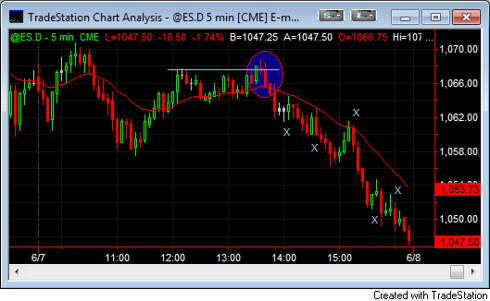There are many ways to determine the trend in a market and most of them are pointing lower for the stock markets. Major trendlines have been broken, the 200-day moving average has been crossed and rallies are not lasting.
You can see how weak the market was on Monday as the market tried to rally but the follow through was squashed. This tells me investors want out and they are selling rallies. I normally daytrade, but these patterns are also occurring on the daily charts.

On Monday, you can see how he market tried to break out of the lunchtime consolidation around 1:30. The breakout quickly reversed and that set the tone for the remainder of the afternoon. Rally attempts after the breakdown were quick failures and they often present some of the best setups.
You don’t want to take buy signals in a weak market, especially after the market has clearly broken down. Rather, taking a short position after the buy setups fail is a better course of action. The rally attempts in the afternoon are marked with an “X” and you can see how they quickly failed.
Trading the failures can often keep you on the right side of the market and prevent you from taking those impulse trades when the market looks like it is reversing. The fast market conditions also give you plenty of room for profits when you are trading failures.
Chuck Kowalski, FuturesBlog.com
Chuck Kowalski, FuturesBlog.com
Disclosure: no open positions